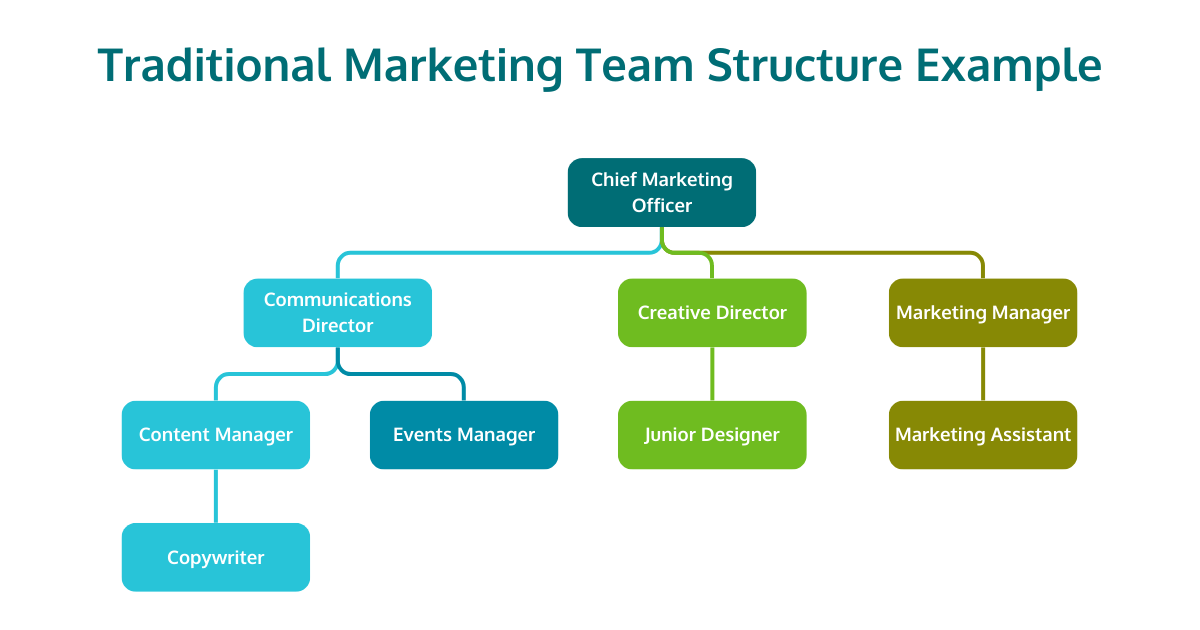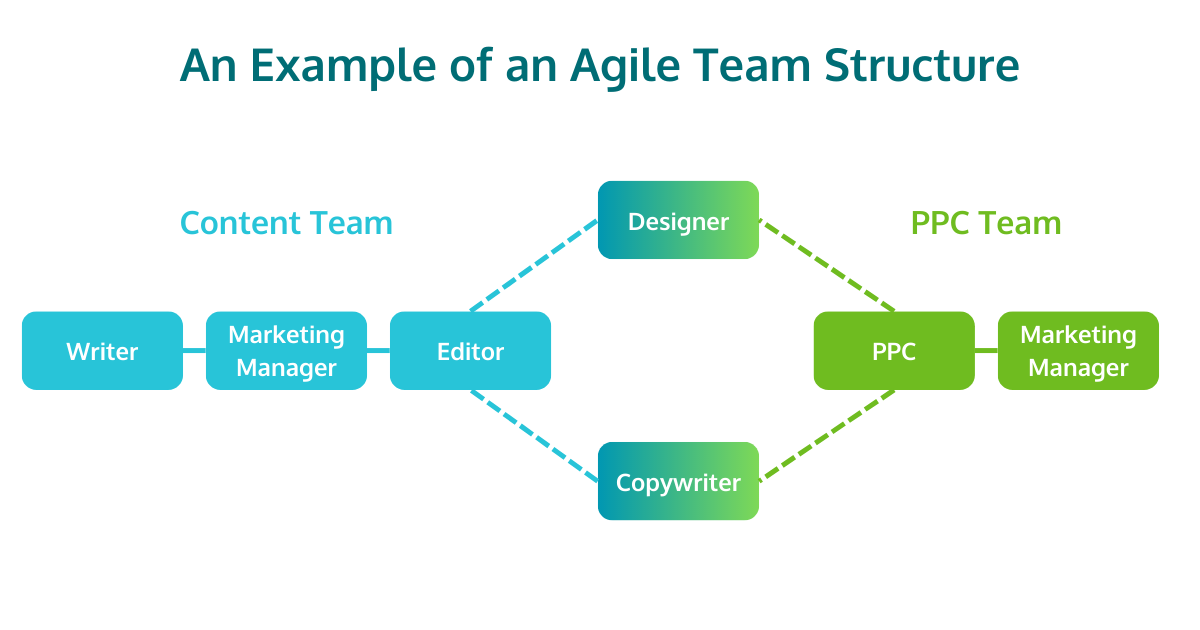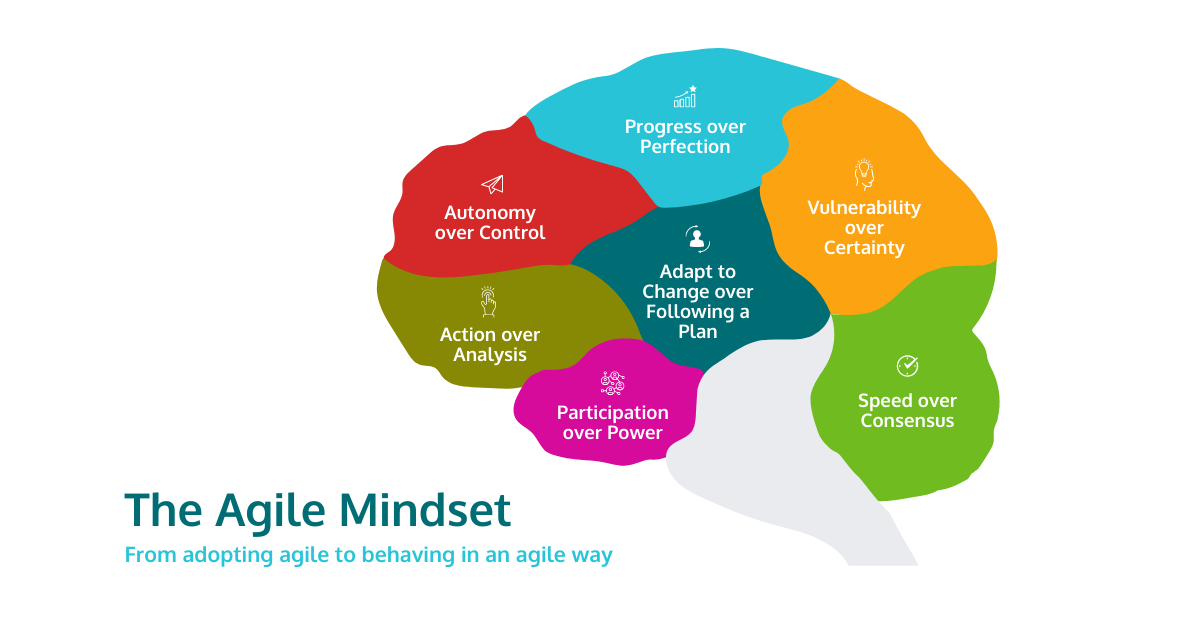Improve your Marketing Ops every week
Subscribe to our blog to get insights sent directly to your inbox.
Confront your process problems head on with a Sherpa by your side.
Explore support options that are tailored to meet you wherever you are on your climb.
Learn from the stories of marketers already on the road to process improvement.
Featured Resource

State of Agile Marketing
Learn from 8 years of study on how marketers are increasing their agility.
Download Report
Recently, a subscriber to our blog newsletter wrote to us asking about whether marketing teams can forego org charts to get work done. They were curious about how teams using different structures can deconstruct work so they can deliver it more incrementally while still delivering the same value.
In short, it’s absolutely possible to do both!
By using the Agile approach to marketing team structures you can get more work done, in part by breaking it down into smaller parts. But there’s actually a lot more to it. Below, we break down everything you need to understand about Agile marketing team structures and how you can use them to deliver better business outcomes.
Of course, if you have your own questions or just want to uncover more ways to use Agile for better marketing, subscribe to our newsletter in the box to the right. You can also reach out directly by emailing us.
Let’s begin with understanding the status quo.
Most larger organizations have marketing departments with rigid structures. Each team member has a defined role within a clear hierarchy. While this certainly makes it crystal clear who should do what, it’s not very adaptable when circumstances change.

What does that look like in practice?
For one, it creates a culture of “that’s not my job/problem,” because the ultimate responsibility lies with team or department leaders. People end up waiting for instructions instead of taking the initiative to solve problems. After all, a writer, designer, or other team member within marketing likely sees their role as merely performing the tasks they're given instead of ensuring the entire team delivers value to their stakeholders.
In other cases, when someone is sick, on vacation, or otherwise not available, those rigid processes and roles can quickly break down and create costly delays.
Put another way, the problem with traditional team structures lies both in their rigidity and in the culture they create. They are not adaptable, accountable, or even very enjoyable to be a part of (based on our past experiences). But for most of us, these traditional ways of working are all we know.
So what does the alternative even look like?
At its core, Agile marketing team structures are relatively flat and flexible. (We say "relatively" because it wouldn't be very Agile to have a one-size-fits-all approach, so we’ll also talk about how even more traditional organizations can still get some of these benefits without a total reorganization.)
The general idea is that an Agile marketing team should focus on giving each member the autonomy, information, and tools they need to deliver value to stakeholders. Everything else can be tweaked as long as that's the goal.
Still, it does help to have an Agile expert assist you in adapting these approaches to your needs.

This means teams are structured so individual members can adjust their roles, stepping in where needed to ensure the work gets done. But that’s easier said than done, so let’s break down the elements that make this possible.
In short, cross-functionality is simply the ability of individual team members to perform a variety of tasks. For example, when multiple team members are able to write copy, the main copywriter not being available doesn’t grind a project to a halt.
In practice, this means teams are less reliant on a single person for that critical work to get done.
The result is marketing that is more predictable, sustainable, and value-creating. Extra work and stress are avoided, but teams also just feel good about their ability to overcome challenges together.
After all, this is a core value of Agile marketing for a reason.
Many of the problems with traditional marketing team structures stem from a lack of cross-functionality.
It’s easy to dismiss this concept as a buzzword or an unattainable ideal, but unlocking the benefits of cross-functionality begins with being practical about it. In fact, you can get most of those benefits through three simple steps.
One of this is understanding what roles everyone can play by using skill mapping to get a clear idea of what abilities each team member has. If you don't take any other steps right now, this one alone can improve your team's ways of working.
We mentioned how Agile marketing teams usually have flat structures, and collaboration is another major reason why. When teams lack hierarchy, it becomes far easier for members of that team to freely collaborate instead of deferring to whoever is higher up.
This ties into cross-functionality, because no member should feel it’s above or below them to step in and help when needed. Even the types of Agile meetings you may use are designed to put everyone on an equal footing so they can more easily communicate and collaborate.
Nothing ever stands still in business or in marketing. Our ability to adapt to that inevitable change is a big part of what allows great marketers to deliver those better outcomes.
Obviously, cross-functionality makes it far easier to adapt in many situations, but adaptation is about more than how you respond to a short-term challenge or crisis. It’s just as important to evolve your team structures over time.
One of the worst mistakes marketing teams make is finding some process or structure that works and assuming it’s going to work forever.
As marketers, we know that even the world’s best strategies have a limited shelf life.
This is why Agile marketing is built around continuous change, with regular meetings specifically designed to evaluate what’s going well, come up with ideas for improvement, and rigorously test those ideas.
The original question which prompted this post asked about marketing team structures that might help with how work flows in and out of teams. One of the most effective ways to address that specifically is through SLAs.
SLAs are agreements governing how work gets brought into a team, how it gets done, and when it will be delivered. By specifying all this information, along with things like quality standards, SLAs help ensure processes remain consistent, proper expectations are set, and boundaries are clearly defined.
For this reason, they’re extremely helpful in managing unplanned work because they equip teams with a way to push back on things that don’t fit within the SLA they agreed upon.
This may sound overly rigid compared to the flexibility we’ve talked about so far, but bear in mind that SLAs are informal agreements, not binding contracts. They can and should change over time. Think of them simply as ways to get everyone on the same page about how work should happen.
Before proceeding to learn why new organizational structures require new mindsets, why don't you take a second to get our Agile Marketing Transformation Checklist?
Giving a team a new structure and thinking you’re done is a recipe for failure. Old habits die hard, so it’s important to consciously put effort into building a new mindset to accompany that new structure.
After all, if marketing team members have been deferring to a more senior person for years, that’s unlikely to change overnight simply because someone told them their team was flat now.

Transitioning from a fixed to an Agile mindset is key for success here.
This can be done through courses designed to get marketers familiar with the basics of how Agile works. Ideally, however, this will be led by an Agile expert. This could be someone internal who has gone through more intensive training or an external partner.
The reason this approach helps is that changing mindsets takes time, often involving answering questions and adapting practices to on-the-ground realities. An experienced Agile practitioner is going to be far better equipped to fill this role compared to someone without that level of experience.
The good news is that you don’t necessarily have to throw your old org chart into the trash to get these benefits. We know this because we’ve helped companies in traditional and highly regulated industries like banking and pharmaceuticals where org charts didn’t necessarily change, but individuals did take on more flexible roles as needed.
In other words, Agile team structures aren’t just for small startups or companies willing to spend the next year reorganizing themselves.
Ultimately, making the transition to an Agile marketing team structure has to start with getting everyone familiar with Agile practices and excited about the benefits they will bring. That’s why it’s helpful to start with training and coaching from people with experience helping companies like yours make this precise kind of transition.
Fortunately, we offer a wide range of courses and coaching specifically designed to help you unlock the full benefits of Agile marketing.
Whether you’re curious to just learn more or feel ready to try creating Agile marketing teams, we can help you find the best way to achieve your goals.
Before you move on, don't forget to get your copy of the Agile Marketing Transformation Checklist.
Subscribe to our blog to get insights sent directly to your inbox.
Subscribe to our blog to get insights sent directly to your inbox.